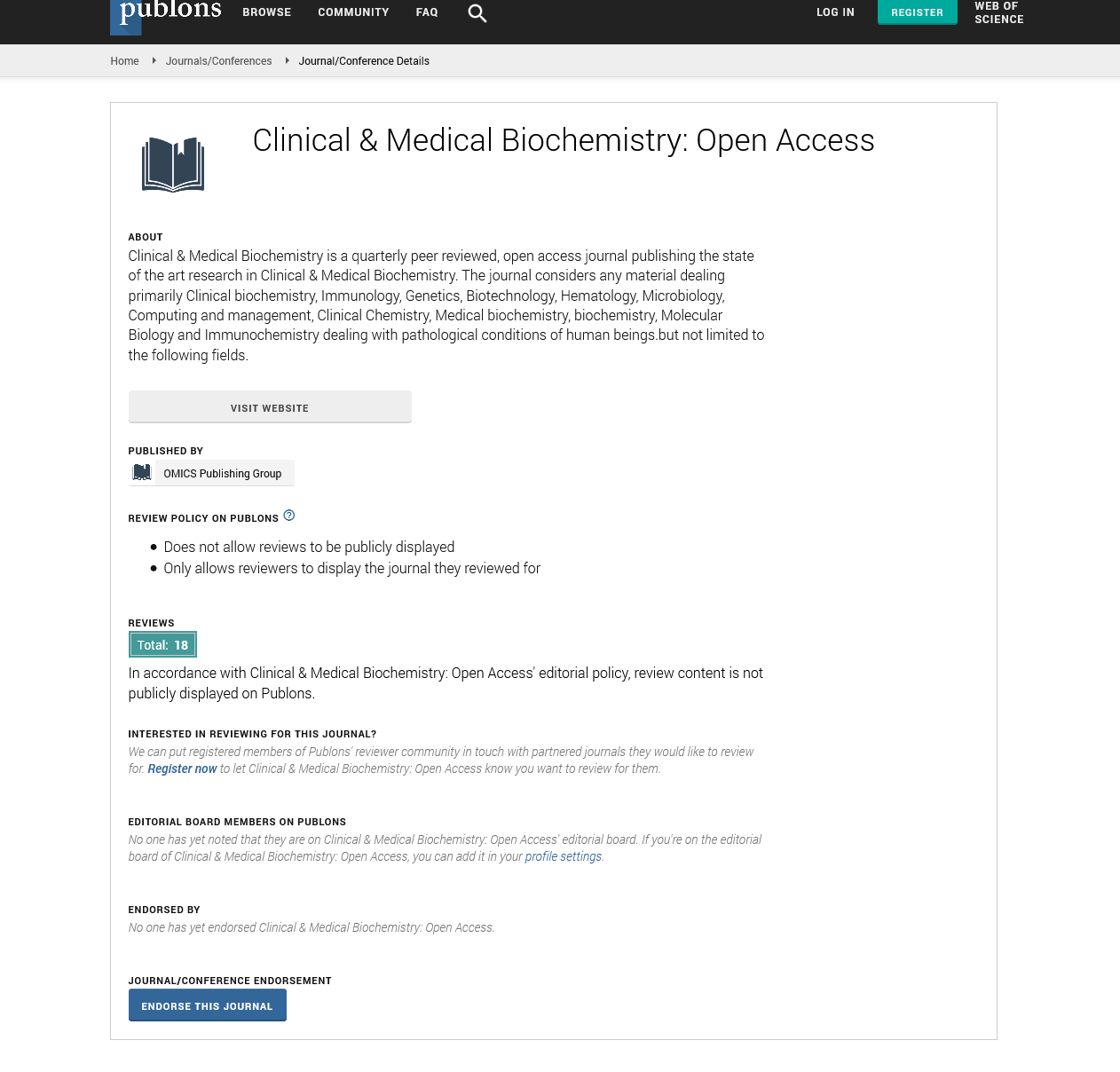Indexed In
- RefSeek
- Directory of Research Journal Indexing (DRJI)
- Hamdard University
- EBSCO A-Z
- OCLC- WorldCat
- Scholarsteer
- Publons
- Euro Pub
- Google Scholar
Useful Links
Share This Page
Journal Flyer
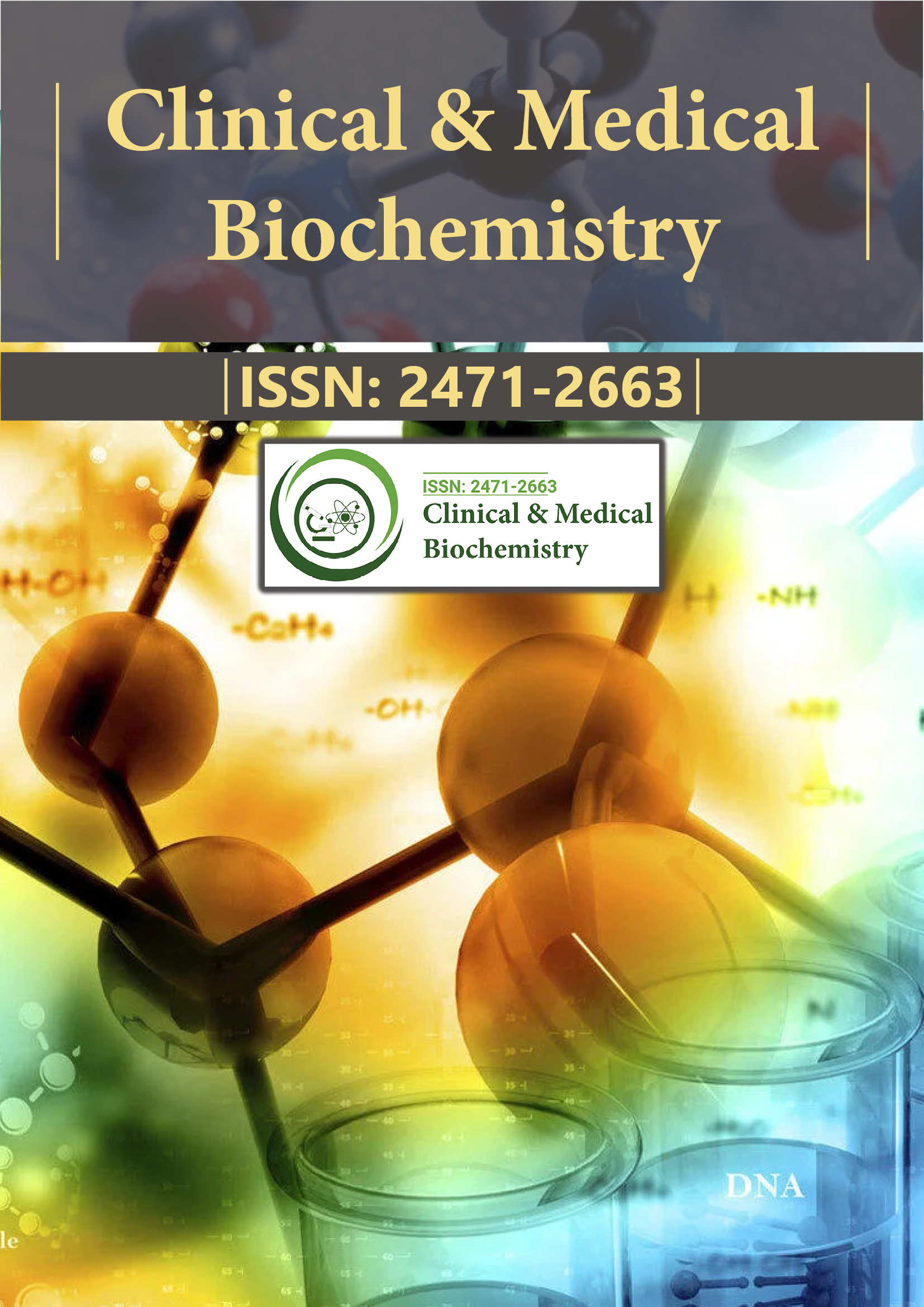
Open Access Journals
- Agri and Aquaculture
- Biochemistry
- Bioinformatics & Systems Biology
- Business & Management
- Chemistry
- Clinical Sciences
- Engineering
- Food & Nutrition
- General Science
- Genetics & Molecular Biology
- Immunology & Microbiology
- Medical Sciences
- Neuroscience & Psychology
- Nursing & Health Care
- Pharmaceutical Sciences
Research Article - (2022) Volume 8, Issue 2
Serum Amylase and Lipase Concentrations in Patients with Acute Pancreatitis Attending a Tertiary Care Hospital of National Medical College and Teaching Hospital
Surendra Marasini*, Sanjay Kumar Sah, Suprita Gupta, Anup Shamsher Budhathoki and Nirdhan YadavReceived: 14-Mar-2022, Manuscript No. CMBO-22-15777; Editor assigned: 17-Mar-2022, Pre QC No. CMBO-22-15777 (PQ); Reviewed: 31-Mar-2022, QC No. CMBO-22-15777; Revised: 07-Apr-2022, Manuscript No. CMBO-22-15777 (R); Published: 14-Apr-2022, DOI: 10.35841/2471-2663.22.8.118
Abstract
Background: Acute pancreatitis is an inflammation of the pancreas. The causes of acute pancreatitis include alcohol consumption, gall stones, and other metabolic factors. The diagnosis of acute pancreatitis is made based on epigastric pain radiating to the back, the elevation of pancreatic amylase and pancreatic lipase activity in serum, and supportive radiological findings.
Methods: This was a hospital-based cross-sectional study conducted in the tertiary care hospital of National Medical College and Teaching Hospital, Birgunj, Nepal. Two hundred and fifty-six patients who had undergone their amylase and lipase from clinical laboratory services were enrolled for the study.
Results: Our results showed the pattern of elevation of serum amylase and lipase in patients with acute pancreatitis. Both amylase and lipase were elevated in 23.43% of patients. ROC curve revealed the area under the curve of lipase was 0.99 (P-value: 0.00) and for amylase was 0.90 (P-value: 0.03). The mean rank of amylase for acute pancreatitis was 196.77 and for lipase was 202.30 which was a statistically significant difference from the control group (P-value: 0.01).
Conclusion: Our study revealed that lipase can give better diagnostic value in comparison to serum amylase for the diagnosis of acute pancreatitis. However, both serum amylase, as well as lipase measurement, can be done simultaneously instead of amylase only for a better diagnosis.
Keywords
Acute pancreatitis; Amylase; Lipase; Inflammation; Enzyme activity
Introduction
Acute pancreatitis is an inflammation of the pancreas. The incidence of acute pancreatitis varies in different countries and depends on causes such as alcohol consumption, gall stones, metabolic factors, drugs, etc. [1]. Pancreatitis is diagnosed when there is evidence of increased amylase and lipase depending on etiology and clinical picture [2,3]. Acute pancreatitis may be associated with the variable involvement of the adjacent organs or organ system [4]. The most common causes of acute pancreatitis are gallstones and excessive alcohol consumption. Approximately 50%-70% of cases of acute pancreatitis are caused by gallstones [5,6].
As per the classifications of pancreatitis, the diagnosis of acute pancreatitis is made when at least two of the following features are present in the patients. Severe epigastric pain radiating to the back, increased enzyme activity (amylase or lipase) more than three times upper limit of normal, and any radiological findings of acute pancreatitis, then the patient is considered as acute pancreatitis [7].
Amylase is an enzyme secreted by the pancreas. Various other tissues including salivary glands, small intestine, ovaries, adipose tissues, and skeletal muscle secrete amylase. There are two major isoforms of amylase, pancreatic amylase, and salivary amylase [8]. Another enzyme secreted by the pancreas is lipase. The main reason for an increase in serum lipase is acute pancreatitis. The serum lipase remains elevated for a longer period compared to the elevation of serum amylase after acute pancreatitis [9]. Because of short half-life of amylase it may be cleared from the circulation, so the amylase elevation can be missed in up to 50% cases of acute pancreatitis, when the blood sample is taken after some time of onset of pancreatitis [10].
Sometimes, the radiological diagnosis (both CT and USG) also fail to detect acute pancreatitis [11,12]. Estimation of pancreatic enzymes aids the diagnostic sensitivity and specificity for the diagnosis. This study aims to find out the pattern of elevation of amylase and lipase in acute pancreatitis patients and to find out the diagnostic accuracy of the amylase and lipase to diagnose the acute pancreatitis patients in our population.
Methodology
This was the hospital-based cross-sectional study conducted in a tertiary care hospital of National Medical College and Teaching Hospital NMCTH), Birgunj, Nepal. The study duration was six months (July 2021 to December 2021). The study was conducted after getting the ethical clearance certificate from the Institutional Review Committee of the institution. Two hundred and fifty-six (256) study subjects were enrolled for the study.
The verbal and written consent was taken from the patients before enrolling them into our study. Nonprobability purposive sampling techniques were used to collect the patient’s information. The patient’s clinical histories were taken from the record stored in the hospital’s database.
Amylase and lipase measurements were done in the clinical laboratory services of the NMCTH using the standardized protocol of a fully automated random access clinical chemistry analyzer of Beckman Coulter, AU480 (California, America). The reference ranges for amylase and lipase were 29 to 130 U/L and 11 to 82 U/L respectively as per the manufacturer.
All the data were entered in Microsoft Excel 2010, converted to SPSS version 22 accordingly. Frequency and percentage were calculated for descriptive statistics. The Chi-square test was applied to compare the categorical variables.
The numerical data were expressed in the mean and standard deviation or median and interquartile ranges depending on their distribution. Nonparametric Receiver Operating Characteristics (ROC) curve analysis was done to determine the diagnostic accuracy. Mann Whitney U test was operated to compare the mean ranks and sum of ranks of serum amylase and serum lipase between the acute pancreatitis group and control groups. P-value<0.05 was considered statistically significant.
Results
The present study investigates acute pancreatitis in patients who had visited the Clinical Laboratory Services for the diagnosis of acute pancreatitis. Out of 256 patients enrolled for the study, 86 patients (33.59%) were diagnosed with pancreatitis based on the elevation of both amylase and lipase, and the remaining 170 (66.40%) were healthy individuals. The Receiver Operating Characteristics (ROC) curve was plotted to evaluate the diagnostic performance of the test. On the Y-axis sensitivity and X-axis 1-specificity was plotted. The area under the curve of lipase was 0.99 (P-value: 0.00) and for amylase was 0.90 (P-value: 0.03) as depicted in Figure 1.
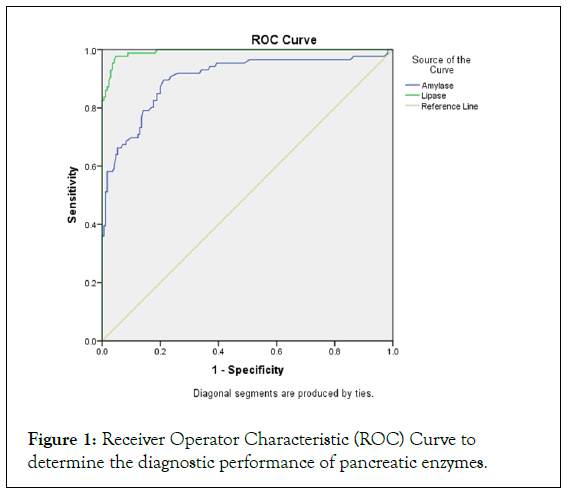
Figure 1: Receiver Operator Characteristic (ROC) Curve to determine the diagnostic performance of pancreatic enzymes.
Table 1 illustrates there is no significant difference in age between acute pancreatitis and controls. There is a significant difference of gender between case and control groups, however male patients predominates in the acute pancreatitis group. There is a significant difference in amylase and lipase concentrations between acute pancreatitis and the control subjects. However, there is no significant difference in age. There is a significant difference in mean rank and the sum of ranks of amylase and lipase between acute pancreatitis and control groups (P-value<0.00).
| Variabes | Acute pancreatitis | Controls | P* value |
|---|---|---|---|
| Gender (Male/Female) | 86 (53/33) | 170(88/82) | 0.04* |
| Age (years) | 41.36 ± 17.52 | 44.59 ± 18.16 | 0.17 |
| Amylase (U/L) | 196.77 (16,922.0) | 93.96 (15,974.0) | 0.000* |
| Lipase (U/L) | 202.30 (18,257.0) | 86.11 (14638.50) | 0.000* |
Note: *indicates P-value ≤ 0.00.
Table 1: Comparison of study variables between acute pancreatitis and healthy controls (n=256).
Figure 2 illustrates the three different patterns of enzyme elevation. This revealed that are elevated amylase and lipase 60 (23.43%), only lipase elevation pattern 20 (7.81%), and only amylase elevation 6 (2.34%). However, 170 (66.40%) were control individuals.
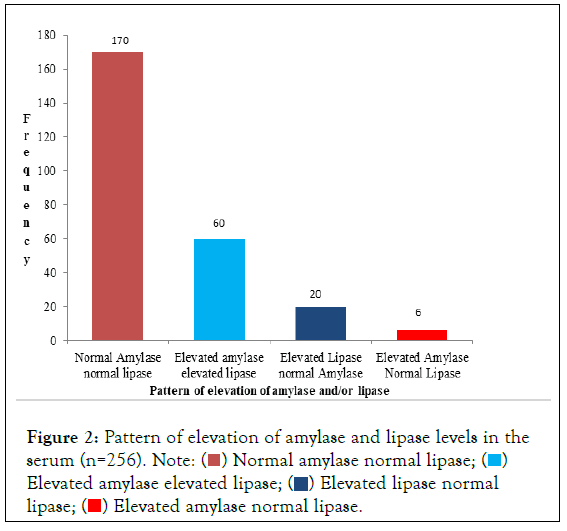
Figure 2: Pattern of elevation of amylase and lipase levels in the serum (n=256). Note: ( ) Normal amylase normal lipase; (
) Normal amylase normal lipase; ( ) Elevated amylase elevated lipase; (
) Elevated amylase elevated lipase; ( ) Elevated lipase normal lipase; (
) Elevated lipase normal lipase; ( ) Elevated amylase normal lipase.
) Elevated amylase normal lipase.
Spearman’s correlation analysis shows the significant positive correlation of amylase with lipase and vice versa (r=0.678, P=0.000) and the pattern of elevation (r=0.571; P=0.000). Both the enzymes are negatively correlated with the groups, as shown in Table 2 (Figures 3 and 4).
| Pancreatic enzymes | Amylase (r,P) | Lipase (r,P) | Group (r,P) | Pattern (r,P) |
|---|---|---|---|---|
| Amylase | 1,0.000 | 0.678,0.000 | -0.364,0.000 | 0.511,0.000 |
| Lipase | 0.678,0.000 | 1, 0.000 | -0.616,0.000 | 0.571,0.000 |
Table 2: Correlation analysis of amylase and lipase between groups and patterns (n=256).
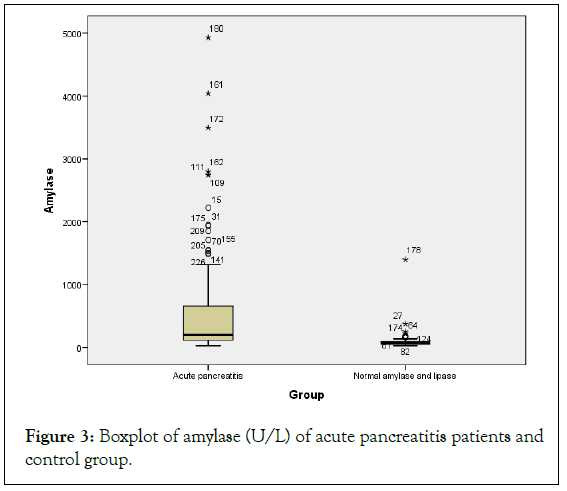
Figure 3: Boxplot of amylase (U/L) of acute pancreatitis patients and control group.
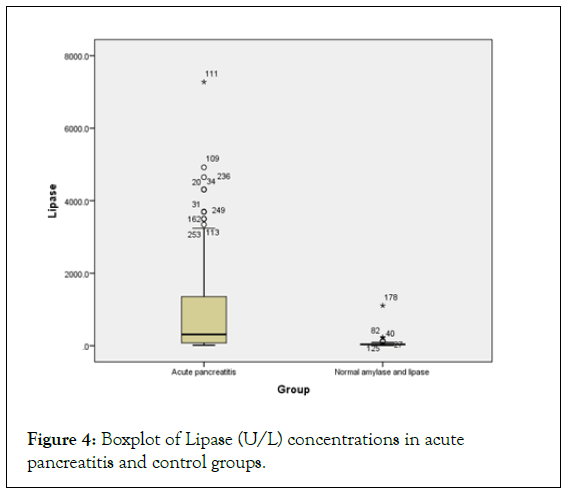
Figure 4: Boxplot of Lipase (U/L) concentrations in acute pancreatitis and control groups.
Discussion
Acute pancreatitis is the sudden inflammatory process of the pancreas with variable involvement of adjacent organs [1]. Serum amylase and lipase are two pancreatic enzymes used to diagnose acute cases of pancreatitis [2-6]. The present study reveals the elevation of amylase and lipase in patients with acute pancreatitis. The diagnostic performance of the lipase was better in comparison to the amylase level in our study. Some studies reported the use of lipase in the diagnosis of acute pancreatitis because of its early as well as persistent elevation [13,14].
The serum lipase level is the best pancreatic enzyme for the diagnosis of acute pancreatitis and the differential diagnosis from other amylase elevating diseases [15]. Current study also revealed that the lipase is more strongly correlated with acute pancreatitis than amylase level. Lorentz reported a similar finding and they also mentioned that amylase has been used for the diagnosis of acute pancreatitis because of its reasonable cost for the measurement. The amylase level is less strongly correlated with acute pancreatitis because the measure of total amylase also includes alpha-amylase from salivary glands and different macro amylase molecules [16].
However, Beauregard et al. reported in the review article that several prospective and retrospective studies did not find any significant diagnostic advantage of lipase over the serum amylase level in the patients of acute pancreatitis contradicting our findings [17].
Our study also revealed the diagnostic sensitivity and specificity of lipase is more in comparison to the amylase in agreement with some authors, they also emphasized the use of lipase only instead of co-ordering both amylase and lipase levels for the diagnosis of acute pancreatitis. This also eliminates the unnecessary expenditure of the patient and lipase has a large diagnostic window as compared to the serum amylase level [18].
Conclusion
Our results revealed the elevation of amylase and lipase in acute pancreatitis patients. Serum lipase was found to be more accurate for the diagnosis of acute pancreatitis in our population. Despite the short half-life of amylase it is most commonly preferred in our laboratory because of its cost effectiveness. However, both serum amylase, as well as lipase measurement, can be done simultaneously instead of amylase only for a better diagnosis.
Limitations
The study duration was short; the follow-up of the patient was not done and the sample size was small.
Acknowledgements
All the patients and laboratory staff of National Medical College, Birgunj, Nepal are heartily acknowledged.
Disclosure
The authors of this publication declare that there is no conflict of interest with any financial or scientific organizations.
REFERENCES
- Kasper DL, Hauser SL, Fauci AS. Harrisons internal medicine (19th Edn). Mc Graw Hill Education, New York, 2015; pp:2088.
- Yang RW, Shao ZX, Chen YY, Yin Z, Wang WJ. Lipase and pancreatic amylase activities in diagnosis of acute pancreatitis in patients with hyperamylasemia. Hepatobiliary Pancreat Dis Int. 2005;4(4):600-603.
[GoogleScholar] [PubMed]
- Banks PA, Bollen TL, Dervenis C, Gooszen HG, Johnson CD, Sarr MG, et al. Classification of acute pancreatitis-2012: Revision of the Atlanta classification and definitions by international consensus. Gut. 2013;62(1):102-111.
[CrossRef] [GoogleScholar] [PubMed]
- Bradley EL 3rd. A clinically based classification system for acute pancreatitis. Summary of the International Symposium on Acute Pancreatitis, Atlanta, Ga, September 11 through 13, 1992. Arch Surg. 1993;128(5):586-590.
[CrossRef] [GoogleScholar] [PubMed]
- Roberts SE, Akbari A, Thorne K, Atkinson M, Evans PA. The incidence of acute pancreatitis: Impact of social deprivation, alcohol consumption, seasonal and demographic factors. Aliment Pharmacol Ther. 2013;38(5):539-548.
[CrossRef] [GoogleScholar] [PubMed]
- Yadav D, Lowenfels AB. Trends in the epidemiology of the first attack of acute pancreatitis: A systematic review. Pancreas. 2006;33(4):323-330.
[CrossRef] [GoogleScholar] [PubMed]
- Banks PA, Carr-Locke DL, Slivka A, Van Dam J, Lichtenstein DR, Hughes M. Urinary trypsinogen activation peptides (TAP) are not increased in mild ERCP-induced pancreatitis. Pancreas. 1996;12(3):294-297.
[CrossRef] [GoogleScholar] [PubMed]
- Bishop ML, Fody EP, Schoeff LE. Clinical Chemistry, Principles, Techniques and Correlations (7th Edn). Two Commerce Square 2001Market Street Philadelphia, PA 19103 USA, 2013;pp:283-287.
- Burtis KA. Teitz textbook of Clinical Chemistry (7th Edition) Estimation of serum Amylase, Elsevier. pp:375-380.
- Clavien PA, Robert JH, Meyer P, Borst F, Hauser H, Rohner A. Acute pancreatitis and normo-amylasemia, not an uncommon combination. Ann Surg. 1989;210:614-619.
[CrossRef] [GoogleScholar] [PubMed]
- Nordestgaard AG, Wilson SE, Williams RA. Early computerised tomography as a predictor of outcome in acute pancreatitis. Am J Surg. 1986;152:127-132.
[CrossRef] [GoogleScholar] [PubMed]
- McKay AJ, Imrie CW, O’Neill J, Duncan JG. Is an early ultrasound scan of value in acute pancreatitis? Br J Surg. 1982;69:369-372.
[CrossRef] [GoogleScholar] [PubMed]
- Chase CW, Barker DE, Russell WL, Burns RP. Serum amylase and lipase in the evaluation of acute abdominal pain. Am Surg. 1996;62(12):1028-1033.
[GoogleScholar] [PubMed]
- Gumaste VV, Roditis N, Mehta D, Dave PB. Serum lipase levels in nonpancreatic abdominal pain versus acute pancreatitis. Am J Gastroenterol. 1993;88(12):2051-2055.
[GoogleScholar] [PubMed]
- Koizumi M, Takada T, Kawarada Y, Hirata K, Mayumi T, Yoshida M, et al. JPN Guidelines for the management of acute pancreatitis: Diagnostic criteria for acute pancreatitis. J Hepatobiliary Pancreat Surg. 2006;13(1):25-32.
[CrossRef] [GoogleScholar] [PubMed]
- Lorentz K. Studies on clinical significance of lipase and alpha-amylase estimations in pancreatitis sera (author’s transl). Z Gastroenterol. 1980;18:543-546.
[GoogleScholar] [PubMed]
- Beauregard JM, Lyon JA, Slovis C. Using the literature to evaluate diagnostic tests: Amylase or lipase for diagnosing acute pancreatitis? J Med Libr Assoc. 2007;95(2):121-126.
[CrossRef] [GoogleScholar] [PubMed]
- Ferraro S, Braga F, Panteghini M. Laboratory medicine in the new healthcare environment. Clin Chem Lab Med. 2016;54(4):523-533.
[CrossRef] [GoogleScholar] [PubMed]
Citation: Marasini S, Sah SK, Gupta S, Budhathoki AS, Yadav N (2022) Serum Amylase and Lipase Concentrations in Patients with Acute Pancreatitis Attending a Tertiary Care Hospital of National Medical College and Teaching Hospital. Clin Med Bio Chem. 8:118.
Copyright: © 2022 Marasini S, et al. This is an open-access article distributed under the terms of the Creative Commons Attribution License, which permits unrestricted use, distribution, and reproduction in any medium, provided the original author and source are credited.
